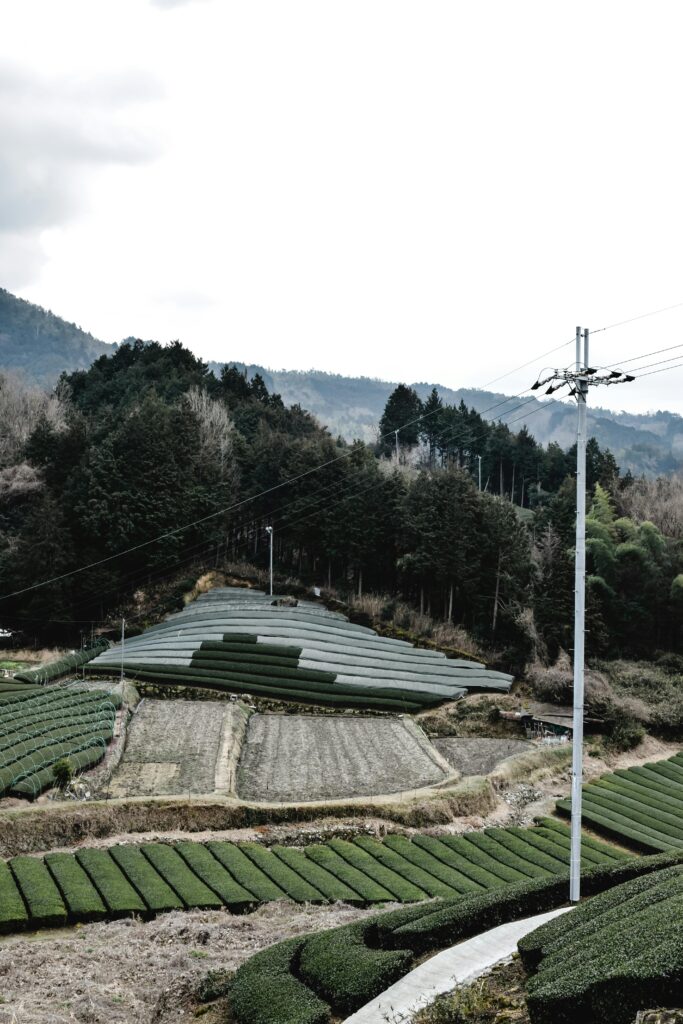Definition of Jikagise in the matcha glossary

Defining Jikagise in Matcha Production
Jikagise is a traditional shading technique used in Japanese tea cultivation that directly covers tea plants with black fabric. This method plays a crucial role in producing high-quality matcha by controlling sunlight exposure during the final growth period. The practice represents centuries of refined agricultural knowledge passed down through generations of Japanese tea farmers.
The term comes from Japanese tea culture, where precise cultivation methods determine the quality and characteristics of the final product. Jikagise specifically refers to the direct-covering approach, distinguishing it from other shading methods used in premium tea production.
How the Shading Process Works
Tea plants undergo jikagise shading for 20 to 30 days before harvest. Farmers drape black fabric directly over the tea bushes, creating a controlled environment that dramatically reduces sunlight exposure. This intentional light deprivation triggers specific biochemical changes within the tea leaves.
The direct contact method creates a unique microenvironment around each plant. Unlike elevated shading structures, the fabric rests closer to the foliage, providing more consistent coverage and protection from environmental variables.
Chemical Changes and Flavor Development
Shading through jikagise fundamentally alters the biochemical composition of tea leaves. When plants receive less sunlight, they produce more chlorophyll to compensate for reduced photosynthesis. This increased chlorophyll content gives matcha its vibrant green color and contributes to its distinctive taste profile.
The reduced light exposure also affects amino acid production. Tea leaves naturally contain L-theanine, an amino acid responsible for the smooth, umami-rich flavor in premium matcha. Shading preserves and enhances these compounds because the plant converts fewer amino acids into catechins, which contribute to bitterness.
Key Benefits for Matcha Quality
The jikagise method delivers several quality improvements that matcha enthusiasts can taste:
- Enhanced sweetness from elevated amino acid levels
- Reduced astringency through lower catechin conversion
- Deeper green color from increased chlorophyll production
- Smoother mouthfeel with less harsh bitterness
- Complex umami notes that define premium grades
Jikagise Versus Other Shading Methods
Japanese tea farmers employ different shading techniques depending on the desired tea type and quality level. Understanding these distinctions helps matcha buyers appreciate the craftsmanship behind their favorite products.
Comparing Direct and Elevated Shading
The primary alternative to jikagise is tana, where farmers construct elevated scaffolding above tea fields. They then lay shading materials across this structure, creating a canopy several feet above the plants. This method allows air circulation and easier access for workers but produces different growing conditions than direct covering.
Tana shading typically costs more to implement because it requires building and maintaining permanent or semi-permanent structures. However, it offers advantages for large-scale operations and can be adjusted more easily throughout the shading period.
Impact on Tea Characteristics
Each shading method influences the final product differently:
- Jikagise creates more intense flavor concentration through closer contact
- Tana allows gradual light adjustment for nuanced flavor development
- Direct covering produces leaves with higher chlorophyll density
- Elevated shading permits better temperature regulation during variable weather
Historical Significance in Japanese Tea Culture
The practice of shading tea plants reflects the meticulous attention to detail that characterizes Japanese tea cultivation. For centuries, farmers have refined these techniques to produce exceptional teas for traditional tea ceremonies. Jikagise emerged as one method to achieve the specific qualities demanded by tea masters and discerning consumers.
This traditional approach demonstrates how Japanese tea culture values process as much as product. The extra labor and care required for jikagise shading align with the broader philosophy of omotenashi—wholehearted hospitality and dedication to excellence.
Modern Applications and Relevance
Today’s matcha producers continue using jikagise alongside newer cultivation methods. Many premium matcha brands emphasize traditional shading techniques as a quality indicator. Consumers shopping on platforms like Best Matcha can often find product descriptions that specify the shading method used, helping them make informed purchasing decisions.
The technique remains particularly important for ceremonial-grade matcha. These highest-quality products require the precise flavor profile that jikagise can deliver. Culinary-grade matcha may use modified or shortened shading periods, but top-tier offerings typically follow traditional timing and methods.
Identifying Jikagise-Shaded Matcha
When comparing matcha products, several indicators suggest jikagise shading was used. The most obvious sign is vibrant, deep green color that appears almost luminescent. This intense hue comes from the elevated chlorophyll levels that develop during extended shading periods.
Taste and Texture Markers
Properly shaded matcha exhibits specific sensory characteristics:
- Smooth, creamy texture without grittiness or chalkiness
- Pronounced umami flavor with natural sweetness
- Minimal bitterness or astringency, even at higher concentrations
- Complex flavor notes that develop across the palate
These qualities become especially apparent when preparing usucha (thin tea) or koicha (thick tea) in traditional preparations. The amino acid content preserved through jikagise shading creates a fuller, more satisfying taste experience.
Price and Grade Considerations
Matcha produced using jikagise typically commands higher prices because the method requires significant labor investment. Farmers must carefully time the shading period, monitor plant health, and hand-harvest leaves at peak quality. These factors contribute to the premium pricing of ceremonial-grade matcha compared to culinary varieties.
Conclusion
Jikagise represents a fundamental technique in premium matcha production, directly influencing the flavor, color, and quality that matcha enthusiasts value. This traditional shading method—covering tea plants with black fabric for 20 to 30 days before harvest—creates the biochemical conditions necessary for exceptional matcha. By understanding jikagise, consumers can better appreciate the craftsmanship behind their matcha and make more informed choices when selecting products.
Whether you’re exploring options on Best Matcha’s marketplace or discussing cultivation methods with other community members, recognizing terms like jikagise deepens your connection to this remarkable beverage. The next time you whisk a bowl of vibrant green matcha, you’ll know that centuries of agricultural wisdom contributed to that perfect cup.
Frequently asked questions
We’re here to help with all your questions and answers in one place. Can’t find what you’re looking for? Reach out to our support team directly.
Discussion: Definition of Jikagise in the matcha glossary





